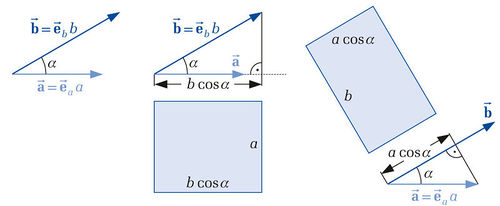Difference between revisions of "Dot product"
| Line 7: | Line 7: | ||
\vec{\mathbf{a}} \cdot \vec{\mathbf{b}} = a \vec{\mathbf{e}}_{a} \cdot b\vec{\mathbf{e}}_{b} = a b \cos \alpha | \vec{\mathbf{a}} \cdot \vec{\mathbf{b}} = a \vec{\mathbf{e}}_{a} \cdot b\vec{\mathbf{e}}_{b} = a b \cos \alpha | ||
</math> | </math> | ||
| − | where <math>\alpha</math> describes the angle between the two vectors which ranges from <math>0</math> to <math>\pi</math> (see figure). The dot product is denoted with a simple point between the vectors or without any sign. | + | where <math>\alpha</math> describes the angle between the two vectors which ranges from <math>0</math> to <math>\pi</math> (see figure). The dot product is denoted with a simple point between the vectors or without any sign. |
| + | |||
Regarding the right side of the above equation, the following correlation can be noted: If you project the vector <math>\vec{\mathbf{b}}</math> on the vector <math>\vec{\mathbf{a}}</math>, you get the distance <math>b\cos\alpha</math>. As a consequence the result of the dot product can be seen as the acreage of a rectangle with the side legths <math>a</math> and <math>b\cos\alpha</math>. The projection can also be done contrariwise (projection of vector <math>\vec{\mathbf{a}}</math> on the direction of vector <math>\vec{\mathbf{b}}</math>). So that you get the distance <math>a\cos\alpha</math>. The multiplication of this term with <math>b</math> leads to a rectangle with equivalent acreage but different aspect ratio (see figure). | Regarding the right side of the above equation, the following correlation can be noted: If you project the vector <math>\vec{\mathbf{b}}</math> on the vector <math>\vec{\mathbf{a}}</math>, you get the distance <math>b\cos\alpha</math>. As a consequence the result of the dot product can be seen as the acreage of a rectangle with the side legths <math>a</math> and <math>b\cos\alpha</math>. The projection can also be done contrariwise (projection of vector <math>\vec{\mathbf{a}}</math> on the direction of vector <math>\vec{\mathbf{b}}</math>). So that you get the distance <math>a\cos\alpha</math>. The multiplication of this term with <math>b</math> leads to a rectangle with equivalent acreage but different aspect ratio (see figure). | ||
Revision as of 13:33, 15 May 2014
| ← Back: Simple arithmetic operations | Overview: Vector algebra | Next: Cross product → |
The dot product of two vectors results in a scalar value and is defined as
where  describes the angle between the two vectors which ranges from
describes the angle between the two vectors which ranges from  to
to  (see figure). The dot product is denoted with a simple point between the vectors or without any sign.
(see figure). The dot product is denoted with a simple point between the vectors or without any sign.
Regarding the right side of the above equation, the following correlation can be noted: If you project the vector  on the vector
on the vector  , you get the distance
, you get the distance  . As a consequence the result of the dot product can be seen as the acreage of a rectangle with the side legths
. As a consequence the result of the dot product can be seen as the acreage of a rectangle with the side legths  and
and  . The projection can also be done contrariwise (projection of vector
. The projection can also be done contrariwise (projection of vector  on the direction of vector
on the direction of vector  ). So that you get the distance
). So that you get the distance  . The multiplication of this term with
. The multiplication of this term with  leads to a rectangle with equivalent acreage but different aspect ratio (see figure).
leads to a rectangle with equivalent acreage but different aspect ratio (see figure).
Another possibility to compute the dot product is to multiply the corresponding components and sum them up:
In general the dot product of n-dimensional vectors is computed as follows:
On the basis of the described relations it appears, that the commutative law holds:
Furthermore the following special cases can be considered, that often lead to simplifications in technical context:
Ein häufiger Anwendungsfall des Skalarprodukts ergibt sich bei dem Begriff der Arbeit. Bewegt man beispielsweise eine Punktladung Bei der Verschiebung der Ladung muss die Coulomb-Kraft Allgemein, also wenn die elektrische Feldstärke nicht homogen und der Weg der Verschiebung von |
Multimedial educational material
|
http://www.mathresource.iitb.ac.in/linear%20algebra/example7.1/index.html Applet: Skalarprodukt zweier Vektoren (engl.) http://www.cs.brown.edu/exploratories/freeSoftware/repository/edu/brown/cs/exploratories/applets/dotProduct/dot_product_java_browser.html Applet: Skalarprodukt zweier Vektoren http://www.mathresource.iitb.ac.in/linear%20algebra/example7.2/index.html Applet: Skalarprodukt zweier Vektoren mit der eingeschlossenen Fläche http://demonstrations.wolfram.com/DotProduct/ Applet: Skalarprodukt zweier Vektoren (engl./ free CDF-Player erforderlich) http://www.math.ethz.ch/~lemuren/public/exercise/linalg/LinearCombinationInR2ETHZ.html Applet: Linearkombination im zweidimensionalem Raum |
Literature
- Kurt Meyberg und Peter Vachenauer, Höhere Mathematik 1: Differential- und Integralrechnung. Vektor- und Matrizenrechnung, 6. Edition (Springer Berlin Heidelberg, 2001)
- Manfred Albach, Grundlagen der Elektrotechnik 1: Erfahrungssätze, Bauelemente, Gleichstromschaltungen, 3. Edition (Pearson Studium, 2011)






 in einem homogenen elektrischen Feld
in einem homogenen elektrischen Feld  entlang einer geraden Strecke
entlang einer geraden Strecke  von einem Punkt
von einem Punkt  zu einem Punkt
zu einem Punkt  , so lässt sich die dabei aufgewendete Arbeit mit Hilfe des Skalarprodukts wie folgt bestimmen:
, so lässt sich die dabei aufgewendete Arbeit mit Hilfe des Skalarprodukts wie folgt bestimmen:

 aufgebracht werden, das heißt in diesem Fall ergibt sich der folgende Zusammenhang:
aufgebracht werden, das heißt in diesem Fall ergibt sich der folgende Zusammenhang:


